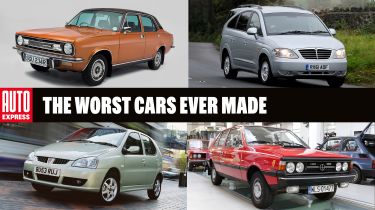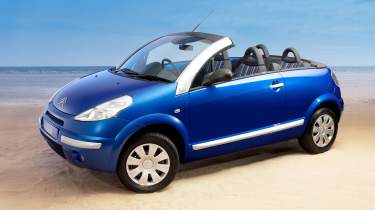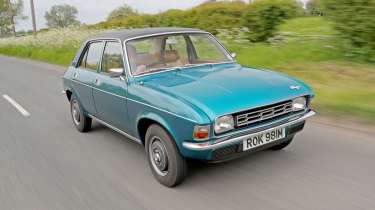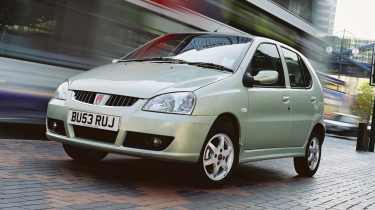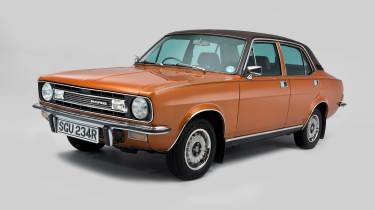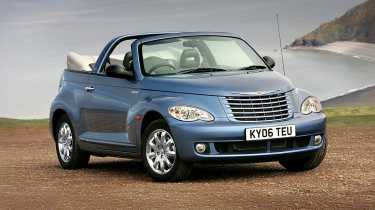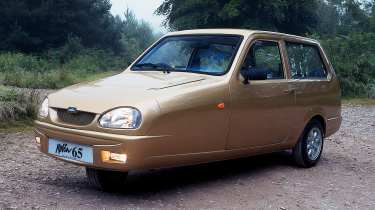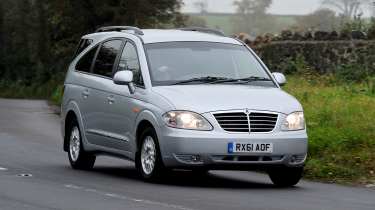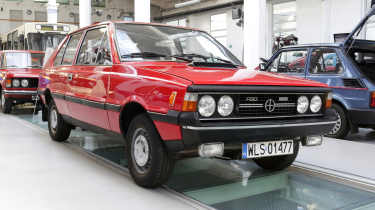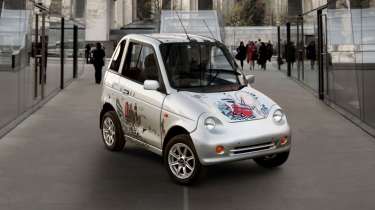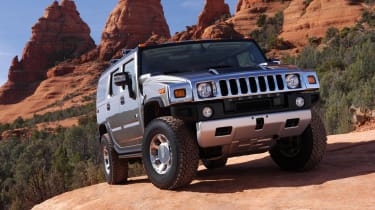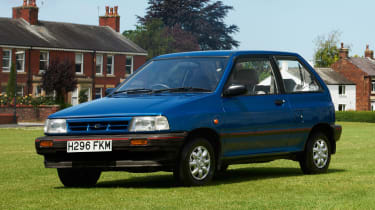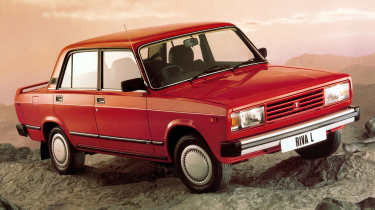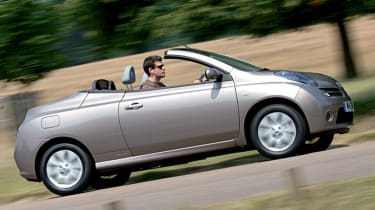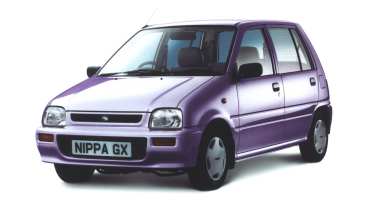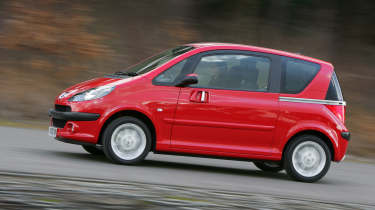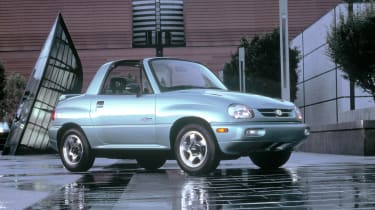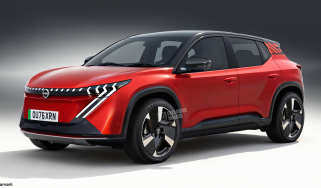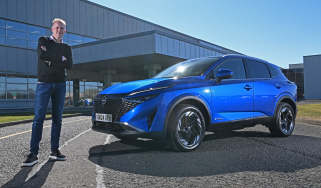The worst cars ever made
We name and shame the thoroughbred stinkers of the automotive world, cars we love to hate
There are many, many horrific contenders for the title of worst car ever made - so many in fact that picking the absolute worst isn’t easy. When you also consider that cars have come a long way over the years, a bad car by modern standards might not necessarily be that awful compared to one from the 1980s. But then again, does that make it even worse when manufacturers miss the mark in this day and age?
In the same breath, there are cars from yesteryear that may have appeared fine at the time, but looking back now it’s easier to see just how bad some of them really were. There are, of course, some models which were dreadful from the start, giving their makers a reputation which could hang over them for decades to come.
Which models are the worst? We’ll let you be the judge, jury and executioner of the following cars…
Citroen C3 Pluriel
- Price new: £12,370
- Price now: £1,600
- Powertrain: 1.4-litre 4cyl petrol; five-speed manual gearbox
- Power: 72bhp
- 0-62/top speed: 0-60 in 13.9 secs/101mph
At the turn of the millennium it seemed like everyone was taking their superminis and hatchbacks and turning them into convertibles. There was the Peugeot 206 CC, Nissan Micra C+C and Volkswagen also had cabriolet versions of its Golf and the ‘new’ Beetle. Citroen joined in on the open-top fun with a soft-top version of its C3.
Central to the C3 Pluriel's issues was the incredibly daft packaging. There was an electronic canvas roof that slid back easily enough, however, removing the unwieldy roof rails was both fiddly and physically draining. Once off, they couldn’t be stored in the car, which meant if it rained at any point on your journey, you were stuffed.
Beyond that, the C3 Pluriel was shoddy in several other respects: the already poor handling got disconcertingly worse with the roof rails removed and the cramped interior felt cheap.
The C3 Pluriel’s design was so bad that parts were actually illegal in the UK. For example, by dropping the rear seats down flat and lowering the tailgate, you could convert the car from its convertible form into its pick-up guise, suitable for carrying surfboards, according to Citroen. But doing so would obscure the number plate and attract the unwanted attention of any nearby police officer.
Designed to be a family hatchback, a saloon with a sunroof, a convertible, a roadster and a pick-up truck, the C3 Pluriel excelled as none of these things. How a vehicle this misguided was signed off as recently as 2003 is anyone’s guess.
Austin Allegro
- Price new: from £1,159
- Price now: from £2,500
- Powertrain: 1.0-1.7 litre 4cyl petrol
- Power: 49/90bhp
- 0-60: 18.4 seconds (1.3 petrol)
For many years the Allegro has vied with the Morris Marina to be the poster child for everything that was bad about British car manufacturing in the 1970s. Some fans say that’s unfair, but the car was developed in a rush to replace the long-running Austin 1100, and buyers were left unimpressed upon its arrival in 1973.
The dumpy styling came as a result of engineering compromises under the skin, but not in a good way – rehashing running gear from other models meant the Allegro was pitiful to drive. What’s more, at a time when the Renault 5 and VW Golf featured practical hatchback rear ends, the Allegro had a saloon-style boot.
Then there was the ‘Quartic’ steering wheel – with the benefit of hindsight fans argue that it was a predecessor to the flat-bottomed wheels used in racing cars – but British Leyland quietly dropped after a hasty facelift arrived in 1975.
The Allegro was the fruit of a merger between Leyland Motors and British Motor Holdings in 1968, when Leyland bosses found out that BMH didn’t have a plan to replace its ancient-yet-still-popular Austin 1100. It's possible that bosses missed that the Allegro's chief rivals were hatchbacks as they rushed it to market, but the lack of a versatile boot was the least of the car's problems.
It wasn't very spacious inside, there was a range of asthmatic engines and the Allegro was priced higher than its chief competitors, too. Cars that did find owners were nothing but trouble, with the constant threat of breakdowns on the horizon. Tightening the wheel bearing nuts a bit too much could result in bearing failure, while motoring folklore would lead you to believe that the Allegro's flexible chassis meant you could seal the doors shut just by jacking it up in the wrong place. No wonder the car earned the nickname 'All Aggro'.
It's fair to say that the Allegro wasn't a sales success. It was on sale for nine years and sold around 650,000 models, but its Austin 1100 predecessor sold 2.1 million examples in all of its badge-engineered guises.
The 1975 facelift addressed a few issues, while another update in 1979 improved the Allegro further. It also saw the introduction of the Equipe, a boy-racer variant with silver paint and funky orange stripes. However, the Golf GTI was on another level, so the Allegro felt even more out of its depth. The arrival of its replacement, the Austin Maestro in 1983, couldn't come soon enough.
Rover CityRover
- Price new: £6,500
- Price now: from £300
- Powertrain: 1.4-litre 4cyl petrol; five-speed manual gearbox
- Power: 83bhp
- 0-62/top speed: 0-60 in 11.9 secs/100mph
MG Rover was already in some financial hot water when it introduced the CityRover into its line-up in 2003. While the British brand had a decent track record with city cars, thanks to the Mini and Metro, this new arrival, based on the Indian-made Tata Indica, was a poorly judged move that blasted yet another hole into the mighty Viking ship’s sinking funds.
While Rovers were long associated with a sense of affordable prestige, the CityRover completely and utterly failed to hide its bargain-basement origins. A budget car can indeed be an appealing prospect, however, this one started from around £6,500, which was a sizable sum at the time. It was difficult to see where this money went, either, because the Rover felt generations older than the competition due to its drab, low-rent cabin, shoddy build quality and rather bland styling.
The CityRover also had a fearsome rival, the Fiat Panda, and this car offered much better value for money. The result was a mere two-year production run for the Rover, while the Fiat plodded on for nearly a decade.
If it had a different badge on it, the CityRover might have stood a chance as a low-cost meets low-expectation car. However, this was a Rover, and Rover buyers had built up certain expectations of these cars throughout the brand’s decades-long history. No generation of Metro was by any means perfect, but these little cars still had enough unique qualities to sell in steady numbers. The CityRover, though, was seemingly doomed from the start, with less than 9,000 units hitting the UK’s roads before the company’s demise in 2005.
To give a tiny bit of credit where it’s due, the CityRover did offer a reasonable amount of interior space considering its size. However, its appeal as a family car was probably tarnished by the fact that even anti-lock brakes were an optional extra.
If you want a CityRover today, you’ll score points for rarity, but finding a tidy one is far from easy.
Morris Marina
- Price new: £575
- Price now: £300-£10,000
- Powertrain: 1.3/1.8-litre 4cyl petrol; four-speed manual gearbox
- Power: 60-95bhp
- 0-62/top speed: 0-60 in 12.1secs/100mph (1.8TC)
How do you replace a genuine motoring icon such as the Morris Minor? Not like this… current consensus is that British Leyland’s Morris Marina, introduced in 1971, was preferable to taking the bus, but only just. Sales of 1.2 million around the world point to a degree of popularity in its day, but contemporary and modern pundits both agree that rivals from Ford, Vauxhall - and almost everyone else - had the Marina beaten on many fronts.
It doesn’t help the Marina’s reputation that it arrived using carry-over suspension tech from the ancient Minor and MGB, a limited range of outdated engines, and awkward dimensions that fell between the Ford Escort and Cortina. In its defence, BL felt the conservative approach would help shift Marinas in Commonwealth markets not ready for ‘exotic’ front-wheel-drive Austins on the drawing board such as the Maxi.
But a lack of brio - and repeated character assassinations from the Top Gear trio - have cemented the Marina’s place in the worst cars ‘hall of shame’.
The Marina suffered from many woes, but underfunding was at the root of many of them, along with BL’s relatively confused product strategy that saw a sporting coupé variant - originally mooted to take on the Ford Capri - relegated to a cheapskate three-door entry model, albeit quite a pretty one.
The Marina had a decent rally record in the 1.3-litre class, though, and a long legacy that’s relevant today. A Marina-inspired floorpan formed the basis for the nascent Korean brand Hyundai’s development of its Pony model, first released in 1975.
Chrysler PT Cruiser Cabriolet
- Price new: £17,925
- Price now: £3,000
- Powertrain: 2.4-litre 4cyl petrol; five-speed manual gearbox
- Power: 141bhp
- 0-62/top speed: 0-60 in 10.6 secs/121mph
Sometimes things just don’t work out despite looking promising, but others seemed very obviously doomed to failure from the start. The Chrysler PT Cruiser Cabriolet is pretty solidly parked in the latter camp.
To try and give the benefit of any doubt, you have to travel back to the beginning of this century, and remember a time where retro car design was proving successful for the likes of the MINI, Fiat 500 and VW’s Beetle. So although not harking back to a specific model, the PT Cruiser was very much of that ilk, trying to tap into nostalgia.
And for the regular ‘estate’ version, it worked briefly. But by the time the Cabriolet came along, the intervening three years had seen the boom turn very much to bust as the PT Cruiser became the poster child for so-called firework cars. Early demand actually saw premiums being paid above list price for new cars in 2002, but once the early adopters were quenched, there was tumbleweed behind. So by 2005, when the flawed drop-top came along, success would have been a challenge if it was a great car. But it really wasn’t.
From the awful seating position to weird and totally impractical top-hinged letterbox boot, it was all just not as good as it should have been. The lacklustre 141bhp 2.4-litre petrol engine was better with a manual gearbox, although the shift wasn’t the most precise, than it was with the power-sapping auto, but it’s not a car to enjoy driving. Visibility with the roof up is really quite poor, and dropping the electric hood revealed the chunky rollover hoop that isn’t helpful when trying to clamber into the rear two seats.
Interior quality isn’t great, with US brands at the time catering very much for a home market that wasn’t as needy as Europeans with things like soft-touch plastics and pleasant cabin quality.
It was a bit of a shame, because executed well, the PT Cruiser Cabriolet could have been a cult icon for the right reasons, rather than embracing the awful.
Yes it has looks that still stand out today - partly because you don’t see many around - but it reeks of exactly what it is; a car built during a rough cost-cutting time for a brand, trying to cash in on a retro wave but without the required charm or driving manners to cut it.
Reliant Robin
- Price new: £1,500 (1975)
- Price now: From £1,500
- Powertrain: 848cc 4-cyl petrol, four-speed manual gearbox
- Power: 40bhp
- 0-62/top speed: 0-60 in 14 secs/85mph
There are plenty of good reasons why 99 per cent of cars have four wheels. Whether that’s for stability, grip and road holding, or simply because decades of development have deemed this layout most suitable; four is categorically better than three.
Yet Reliant once decided there was a gap in the market, largely for motorists who didn’t hold a full licence, but wanted greater protection from the elements than could be provided by a scooter or motorbike. Those rules changed over time, however, meaning most people do in fact need a normal car licence to drive one on the road.
First launched in 1973, the Robin stuck around (with a short break in production through the eighties) until 2001. Not only did the Robin have three wheels instead of four, its sub-900cc engine and four-speed manual gearbox meant a sluggish 0-60mph time of 14 seconds. Some reports say it’ll do 85mph flat out, but you’d have to be mad to give that a crack.
Later versions got gold metallic paint, a walnut dashboard, minilite alloy wheels and a premium stereo, but cost as much as £10,000. In today’s money that’s almost £20k – or about the same as a new MG3 with 200bhp and a decent dose of hybrid assistance. I don’t care if the three-wheeler was capable of more than 70mpg, I know which I’d rather be driving to work in the morning.
Nothing about this automotive monstrosity makes sense; it has to be one of the very worst cars ever made. It’s a hard pass from me.
Ssangyong Rodius
- Price new: £14,995
- Price now: £2,500-£3,500
- Powertrain: 2.7-litre 5cyl turbo diesel, six-speed manual gearbox
- Power: 162bhp
- 0-62/top speed: 0-60 in 14.1 secs/104mph
It’s easy to just look at the 2004 Ssangyong Rodius and claim it as a duffer purely on its aesthetics, but this truly horrid people carrier from one of South Korea’s more eccentric manufacturers really was just as bad as its looks implied.
To begin with, the Rodius is simply huge, with some markets offering four rows of seating for up to 11 people. In European markets, there was seating for eight, and the cabin – despite some lashings of wood-effect plastic – could be likened more to a North Korean prison cell, jagged edges included.
If your throng weren’t horrified enough just to be seen in such a thing, the Rodius’s spectacularly lax attitude to engineering also made it a nightmare to drive. Ssangyong licensed a range of Mercedes engine units for the Rodius, with both a 3.2-litre straight-six and a five-cylinder diesel available – the latter being the only option in Europe. These were robust, if not exactly efficient or refined, but when mounted in a new-millenium Mercedes added up to a perfectly acceptable experience.
The 2,300kg Rodius, on the other hand, would lumber across the road on its castor-like wheels and suspension that could only be described as ‘soft’. One media outlet noted in its contemporary review that under hard cornering the door ajar warning-light would activate, such was the car’s structural rigidity or lack thereof.
However, the Rodius did offer quite astonishing space for the money, costing from less than £15,000 in 2004. The issue is that if you bought one for the family, they’d quickly leave you with little more than child-support payments for the many kids you bought it to cart around in the first place.
Vauxhall Frontera
- Price new: £13,500
- Price now: £1,500-£4,000
- Powertrain: 2.0-litre four-cyl petrol; five-speed manual gearbox
- Power: 113bhp
- 0-62/top speed: 0-60 in 14.5 secs/95mph
Modern family SUVs are designed to be comfortable, economical, desirable and built to stand up to everyday life. The original Vauxhall Frontera, on the other hand, was a bouncy, thirsty, frumpy mess that rivalled Vauxhall’s old British Leyland rival in terms of reliability and shoddy build quality.
Such an abomination was the result of an unholy partnership between General Motors, which owned Vauxhall at the time, and the Japanese maker Isuzu, of which GM once owned a 34 per cent stake. Intended to recreate the desirability of a Land Rover for a fraction of the price, the Frontera was actually just a rebadged Isuzu MU (Mysterious Utility) Wizard – rolls off the tongue, doesn’t it?
Unfortunately, the woeful warlock was actually based on Isuzu’s utilitarian pick-up truck at the time, meaning the Frontera, which would inevitably spend most of its time on the tarmac, rather than treacherous terrain, got an old-school ladder-frame chassis, live-axle suspension and a line-up of Vauxhall’s own fragile and uninspiring petrol and diesel engines.
The original Frontera plagued Vauxhall showrooms from 1991, all the way through to 2003, getting several revisions along the way. These included some post-industrial revolution technology in the form of coil springs at the rear, plus what was perhaps the Frontera’s only merit: Isuzu’s “No-Stop All-Wheel-Drive” system, which allowed you to switch from rear to four-wheel-drive at the push of a button while on the move.
Now, not to say the marketing team at Vauxhall don’t know what they’re doing, but the brand has decided to revive the Frontera nameplate for the electric era, which appears to be the automotive equivalent of trying to bring legwarmers back into fashion – something, we’re told, is actually happening, but are sure nobody asked for.
FSO Polonez
- Price new: £3,900
- Price now: £4,000
- Powertrain: 1.5-litre 4cyl petrol; five-speed manual gearbox
- Power: 82bhp
- 0-62/top speed: 0-60 in 19 secs/90mph
Back in the early 1980s, Poland was a country suffering from huge national debt to the West from which it was trying to recover. That meant that the UK was among several key export markets for its biggest car brand, FSO, but unfortunately for Poland, the Polenez was its least-bad shot.
Despite being the most modern car of FSO’s line-up, it still borrowed dated mechanicals from the Fiat 125 from the 1960s, so it fell well short of modern standards. The 1.5-litre engine was rough, and contemporary road tests considered it crudely finished and poor to drive.
Even its price point as one of the UK’s cheapest new cars couldn’t save it. Worst of all, however, was that dumpy styling. Staggeringly, two of car design’s greatest names, Walter Da Silva and Giorgetto Giugiaro, had a hand in the pre-facelift Polonez’s looks.
Reva G-Wiz
- Price new: £9,995
- Price now: £1,000
- Powertrain: 1x e-motor, 9.6kWh battery
- Power: 17bhp
- 0-62/top speed: N/A secs/50mph
The hateful, totally passionless and downright dangerous Reva G-Wiz gave electric cars a bad name. Of course, it was almost entirely Londoners who had to resist the urge to throw the dinky electric car into the Thames or down open manholes, because the G-Wiz lacked the power, range and, let's be honest, sufficient engineering to be driven on the open road.
Then again, the G-Wiz was never classified as a proper car. It’s technically a quadricycle, just like today’s Citroen Ami, meaning anyone who was 16 or older and had passed their CBT motorcycle test could get behind the wheel. Unfortunately, the G-Wiz will earn you zero street cred when compared to anything you can ride on two wheels.
The G-Wiz was built at Reva's factory in Bangalore, India, from 2001-2012, but quality control wasn't exactly to Audi standards. The bug-eyed front end and tall, flat panes of window glass make it look awkward, while the variety of crooked shut lines on every model and mismatching paint finishes meant no two cars left the factory looking the same. If you were really unlucky, the G-Wiz would leave enough of a gap between the bodywork and doors to let the rain in, too.
Reva claimed that there was room for two adults and two kids inside, but you’d be packed in like battery hens and the G-Wiz’s inferior electric motor would probably succumb to the challenge of propelling that many people. The original DC motor boasted a heady 13kW of power, which is the equivalent of 17bhp and the amount you’d get from a modern car’s starter motor. The reason the G-Wiz was capable of moving under its own steam (with one person onboard, mind you) is because it weighed around 600kg.
Early cars had six conventional lead-acid batteries under the seats, giving the G-Wiz an official range of 50 miles. In reality the batteries would be flat long before then, especially if you had tried to attain the G-Wiz's faintly terrifying 50mph top speed.
An upgrade to an AC electric motor and better batteries meant more consistent charging for later models, although even better was the addition of disc brakes up front. Yes, that's right, while the old G-Wiz could accelerate briskly enough for some people, drum brakes made an absolute meal of stopping in a timely fashion.
However, the biggest problem with the G-Wiz was the comparative lack of safety it delivered. It was only after 2008 that it had any semblance of a crash structure, developed with the help of Lotus, but even then, the G-Wiz was a potential rolling coffin at any speed above 30mph. A motorbike may be unsafe, but at least you have the option of stepping off to avoid an accident, with the G-Wiz, you're stuck.
It’s almost hard to believe that the G-Wiz was the best-selling electric car in the world up to 2009. Although as soon as major manufacturers finally launched proper electric models, the G-Wiz was immediately consigned to the worst cars of all time charts, where it’s safer for everyone.
The worst of the rest
These cars didn't quite make our main worst cars ever made list, but they're almost as bad...
Hummer H2
The Hummer H2 was revealed in 2002 and designed to mimic the military’s Humvee; a tool for navigating warzones and striking fear into the enemy. Quite why this appealed to some American car buyers is a mystery, but the H2’s reputation is anything but.
You see, the H2 never escaped the impression that it was all bark and no bite. It retained the Humvee’s hoops on the hood that allowed the military machine to be dropped from airplane cargo holds, but on the H2 they weren’t actually stuck to anything, so were entirely pointless.
The H2 also retained the alloy wheel caps that protected the Humvee’s tyre inflation system. But the H2 didn’t have a tyre inflation system, so again the feature was useless. Visibility was rubbish too, any why? The rear windscreen was reduced in size to make way for air vents that were entirely fake.
Then there was the driving experience. The H2 was widely thought to be uncomfortable, with a variety of rattles on the move suggesting build quality wasn’t up to much. It started off with a 6.0-litre V8 engine but 0-60mph took a good 10 seconds, and the fuel economy was embarrassing: General Motors was fortunate that it didn’t have to give official figures owing to the H2’s weight, but several publications ran tests that returned 10mpg.
Of all the great US exports, the Hummer H2 isn’t one of them.
Kia Pride
In 2018 Kia was declared the ‘Company of the Last 30 Years’ at the Auto Express New Car Awards, in recognition of its progress as a manufacturer in the UK.
Today, modern Kias are well-built, practical, economical and good value for money, but that hasn’t always been the case. The South Korean firm’s first contribution to the UK market was the Kia Pride in 1991, and the kindest thing that can be said about it is that it serves as a stark reminder of just how far (we really can’t stress the ‘far’ enough here) the brand has come in the past three decades.
Manufactured in South Korean under licence from Ford, the Kia Pride was actually based on the Ford Festiva. When it finally arrived on these shores, it was only offered in the most basic L trim possible, which had famously horrible, white-walled tyres - the cherry on top of an already quite ugly, boxy exterior design.
Initially it was offered with a 1.1- or 1.3-litre engine, although the former was killed off after a couple of years when Kia moved away from carburettors and added fuel injection technology, rebadging the Pride with the 1.3i monniker. A raft of trim updates followed over the years, but none could alleviate how terrible the Pride truly was. It was briefly pulled from sale in 1999, before returning for one last hurrah that ended for good in 2000.
Lada Riva
What ingredients would you put together to make a dreadful car in the 1980s? You’d probably start with something already quite old, such as the Fiat 124 of the 1960s. Then you’d make it heavier, replace the starter motor with a crank starter for added inconvenience, and then for one final splash of danger, perhaps make the brakes worse. Sounds awful, right?
Regrettably, this is exactly what Russian company VAZ (Volzhsky Avtomobilny Zavod) did to produce the Lada Riva, which has been used as a shining example of ‘why communism is bad’ ever since.
Produced in large numbers for the first time in 1980, the Riva actually started life in 1970 as the VAZ-2101 and didn’t arrive in western Europe until 1983. Producing just 57bhp from a 1.2-litre engine, the long-since obsolete mechanicals meant it was hopelessly unreliable, while the bodywork was vulnerable to rust.
Perhaps surprisingly, the Lada Riva was a successful export in eastern Europe and did well enough in the western side of the continent to justify its sale there well into the nineties. Key to its success was its low price, the car costing just £3,158 (almost £11,000 in today’s money) in 1984.
Eventually emissions regulations and financial uncertainty made it unviable in the region in 1997, although production continued in domestic markets and was still being built in Egypt as recently as 2015. An incredible production run considering how flawed the product was.
Nissan Micra C+C
When the Nissan Micra C+C was launched in 2005, the reviews - while not overly generous - weren’t all that bad: the car earned praise for its build quality, its low running costs, its clever folding roof and even its ride.
However, some mistakes are glaringly obvious with the benefit of hindsight, like when Steve McLaren was appointed England manager, or when Scooch were sent to represent the ever unsuccessful UK at Eurovision with a song entitled Flying the Flag. The Micra C+C is in that category.
Let’s get the styling out of the way: all designs are objective of course, but the C+C’s was the closest thing you could get to what Barbie and Ken might drive if they were made of flesh and not plastic. When TV show Top Gear reviewed the C+C, Richard Hammond felt compelled to wear a bag on his head, such was the embarrassment of being seen driving it.
Elsewhere, the Micra C+C was littered with shortcomings. The four-speed automatic gearbox was sluggish (and £900 more expensive than the manual), the boot space fell dramatically (from 457 to 255 litres) with the roof stowed, and the rear seats were so useless even Barbie in doll form would struggle for leg room. The front seats weren’t exactly spacious either.
Perodua Nippa
Perodua is the largest car manufacturer in Malaysia, having been founded in 1992. The company’s first car was the Kancil, a five-door hatchback that did remarkably well in its home market, allegedly selling over 700,000 units having proved popular with learner drivers.
It eventually came to the UK in 1997, rebadged as the Perodua Nippa. Essentially a lightly modified Daihatsu Mira, the Nippa used an 850cc engine producing just 42bhp. With the car weighing only 675kg the top speed was 84mph, although you’d have been better off measuring the 0-62mph time with a calendar rather than a stopwatch.
As such, the Nippa was designed for (by which we mean ‘only capable of’) city driving, with its narrow dimensions and surprising amount of interior space making it ideal for families needing to get about town. It was also capable of over 50mpg, and its initial £5,000 asking price for the entry-level EX trim made it the cheapest car on sale in the UK at the time.
Not convinced of its terribleness? The Nippa’s blase attitude to safety meant simply getting into one was either an act of bravery or unspeakable stupidity. Airbags? No. Seat-belt pre-tensioners? No. Anti-lock brakes? Not a chance. These were things even the cheapest cars of the time were expected to provide, and the issues were only addressed when the Nippa was replaced with the Perodua Kelisa in 2003.
It did at least have child locks on the rear doors, although quite why you’d want to prevent an innocent youngster from escaping a part-car-part-death-trap is up for debate.
Peugeot 1007
Not all terrible cars are the result of poor decision making. The Peugeot 1007 was previewed as the Sesame Concept car in 2002, causing a lot of excitement among motor show visitors with its electric sliding doors. Peugeot therefore gave the go-ahead to send the car into production, only for the 1007 to be laughed off by actual buyers.
How come? There are a few reasons. While the sliding doors were useful in a tight spot - such as a supermarket car park or multi-storey - access to the rear seats wasn’t really any better than in the average five-door supermini. So the feature wasn’t really worth the effort. Or the added expense, for that matter.
Then there was the weight. The 1007 was a very heavy car for its size at almost 1,300kg, which meant that the engines had to be worked hard to achieve any meaningful acceleration. For one thing this was noisy, and for another it sent fuel economy figures tumbling. Another number that fell dramatically was the price: with the 1007 originally costing £10,000, Peugeot had to chop that figure significantly in order to attract any sales.
Just over 50,000 models were sold in 2005, with a steady decline thereafter until the 1007 was killed off in 2009. Few people missed the stiff ride, cheap materials or ponderous cornering ability, although the doors remain a cheap novelty on the used-car market if you want to impress your friends but can’t afford a Tesla Model X.
Suzuki X-90
Sometimes when a car is designed well, it just looks right. You know? Whether it’s the proportions, or the way the lines highlight the shape or the vehicle, or sometimes it’s just a perfectly judged colour scheme. The Suzuki X-90 was the exact opposite of those things, with styling that was just utterly, utterly wrong.
Not for the first time, a manufacturer fell foul of having so many targets that it failed to hit any of them. Someone at Suzuki had the bright idea of making a sports car that was practical, leading to the creation of the X-90; a two-seater SUV. This sounded great on paper but quickly it became clear that the new offering was neither sporty to drive nor useful to live with.
The X-90 was sold with a 1.6-litre petrol engine that could muster 94bhp, with the option of four- or rear-wheel drive and the choice of five-speed manual or automatic transmissions. As such the X-90 was tremendously slow, and reliability wasn’t great either.
In terms of handling the steering was woeful with lots of vibration arriving through the steering column, and thanks to its high centre of gravity the performance in corners is probably best left undescribed. Add into the mix that the luggage space (already diminished by the presence of the spare tyre) was in terribly short supply, it’s no wonder that the X-90 was removed from sale in the UK after just 18 months.
How the worst cars in the world get made
These days, car manufacturers spend millions on vehicle research and development, so you’d think it would be impossible to produce a bad car. Focus groups tell firms what buyers want, and regular planning meetings help to ensure that every department - from engines and chassis to design and marketing - is pulling in the right direction.
Once a new car is in development, it will be benchmarked against its key rivals to ensure that it can match (and preferably beat) what's already being sold. With all of these things in place, a car manufacturer really will have tripped up quite badly if it manages to produce a total dud.
But it hasn't always been like this. In the past, it felt like some manufacturers had a 'suck it and see' approach to launching a new model. Some cars probably had good feedback when released as a concept, yet the final production model was so badly executed that it destroyed the goodwill of any car buyers who may have been tempted to buy it.
Then you have the badge-engineered models. Some of these try to add polish to an already ageing design with half-baked upgrades, and these tend to be prime ‘worst car’ candidates. And so do efforts where one maker simply takes the fruits of another firm's labours and slaps different badges on it: the end result often falls short of expectations. Finally you have cars that come about as the result of ungodly partnerships between makers that probably seemed like a good idea at the time but clearly weren’t.
On top of that, there was the 70s. Back then the UK car industry was lucky if it got a whole working week out of its staff, as they regularly stopped short at the factory gates to set up a picket and go on strike instead. In the end, the quality of the cars that were eventually built was so poor, it makes you wonder why anybody bothered turning up for work at all.
Tell us if you've ever owned one of the worst cars ever made in the comments below. Then check out our list of the world's most beautiful cars...

